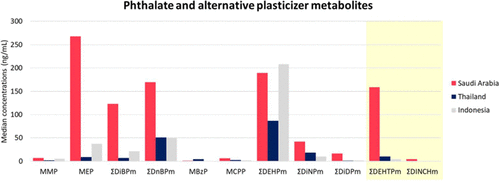当前位置:
X-MOL 学术
›
Environ. Sci. Technol.
›
论文详情
Our official English website, www.x-mol.net, welcomes your
feedback! (Note: you will need to create a separate account there.)
Urinary Concentrations of Major Phthalate and Alternative Plasticizer Metabolites in Children of Thailand, Indonesia, and Saudi Arabia, and Associated Risks
Environmental Science & Technology ( IF 10.8 ) Pub Date : 2021-11-30 , DOI: 10.1021/acs.est.1c04716 Inae Lee 1 , Claudia Pälmke 2 , Benedikt Ringbeck 2 , Yunchul Ihn 1 , Alexandra Gotthardt 2 , Gowoon Lee 1 , Raid Alakeel 3 , May Alrashed 3, 4 , Ramadhan Tosepu 5 , Erwin Azizi Jayadipraja 6 , Kraichat Tantrakarnapa 7 , Wissanupong Kliengchuay 7 , Younglim Kho 8 , Holger M Koch 2 , Kyungho Choi 1
Environmental Science & Technology ( IF 10.8 ) Pub Date : 2021-11-30 , DOI: 10.1021/acs.est.1c04716 Inae Lee 1 , Claudia Pälmke 2 , Benedikt Ringbeck 2 , Yunchul Ihn 1 , Alexandra Gotthardt 2 , Gowoon Lee 1 , Raid Alakeel 3 , May Alrashed 3, 4 , Ramadhan Tosepu 5 , Erwin Azizi Jayadipraja 6 , Kraichat Tantrakarnapa 7 , Wissanupong Kliengchuay 7 , Younglim Kho 8 , Holger M Koch 2 , Kyungho Choi 1
Affiliation

|
Phthalates are widely used in consumer products and are well-known for adverse endocrine outcomes. Di-(2-ethylhexyl) phthalate (DEHP), one of the most extensively used phthalates, has been rapidly substituted with alternative plasticizers in many consumer products. The aim of this study was to assess urinary phthalate and alternative plasticizer exposure and associated risks in children of three Asian countries with different geographical, climate, and cultural characteristics. Children were recruited from elementary schools of Saudi Arabia (n = 109), Thailand (n = 104), and Indonesia (n = 89) in 2017–2018, and their urine samples were collected. Metabolites of major phthalates and alternative plasticizers were measured in the urine samples by HPLC-MS/MS. Urinary metabolite levels differed substantially between the three countries. Metabolite levels of diisononyl phthalate (DiNP), diisodecyl phthalate (DiDP), di(2-ethylhexyl) terephthalate (DEHTP), and 1,2-cyclohexane dicarboxylic acid diisononyl ester (DINCH) were the highest in Saudi children: Median urinary concentrations of oxo-MiNP, OH-MiDP, 5cx-MEPTP, and OH-MINCH were 8.3, 8.4, 128.0, and 2.9 ng/mL, respectively. Urinary DEHP metabolite concentrations were the highest in the Indonesian children. The hazard index (HI) derived for the plasticizers with antiandrogenicity based reference doses (RfDAA) was >1 in 86%, 80%, and 49% of the Saudi, Indonesian, and Thai children, respectively. DEHP was identified as a common major risk driver for the children of all three countries, followed by DnBP and DiBP depending on the country. Among alternative plasticizers, urinary DEHTP metabolites were detected at levels comparable to those of DEHP metabolites or higher among the Saudi children, and about 4% of the Saudi children exceeded the health based human biomonitoring (HBM)-I value. Priority plasticizers that were identified among the children of three countries warrant refined exposure assessment for source identification and relevant exposure reduction measures.
中文翻译:

泰国、印度尼西亚和沙特阿拉伯儿童的主要邻苯二甲酸盐和替代增塑剂代谢物的尿浓度及相关风险
邻苯二甲酸盐广泛用于消费品中,并以不利的内分泌结果而闻名。邻苯二甲酸二(2-乙基己基)酯 (DEHP) 是最广泛使用的邻苯二甲酸酯之一,已在许多消费品中迅速被替代增塑剂取代。本研究的目的是评估三个具有不同地理、气候和文化特征的亚洲国家儿童的尿中邻苯二甲酸酯和替代增塑剂暴露及相关风险。儿童从沙特阿拉伯(n = 109)、泰国(n = 104)和印度尼西亚(n= 89)在 2017-2018 年,并收集了他们的尿液样本。通过 HPLC-MS/MS 测量尿液样品中主要邻苯二甲酸酯和替代增塑剂的代谢物。这三个国家的尿液代谢物水平差异很大。邻苯二甲酸二异壬酯 (DiNP)、邻苯二甲酸二异癸酯 (DiDP)、对苯二甲酸二(2-乙基己基)酯 (DEHTP) 和 1,2-环己烷二甲酸二异壬酯 (DINCH) 的代谢物水平在沙特儿童中最高: oxo-MiNP、OH-MiDP、5cx-MEPTP 和 OH-MINCH 分别为 8.3、8.4、128.0 和 2.9 ng/mL。印度尼西亚儿童的尿液 DEHP 代谢物浓度最高。基于抗雄激素参考剂量 (RfD AA ) 的增塑剂的危害指数 (HI)) 分别在 86%、80% 和 49% 的沙特、印度尼西亚和泰国儿童中 > 1。DEHP 被确定为所有三个国家儿童的共同主要风险驱动因素,其次是 DnBP 和 DiBP,具体取决于国家/地区。在替代增塑剂中,在沙特儿童中检测到的尿 DEHTP 代谢物水平与 DEHP 代谢物相当或更高,约 4% 的沙特儿童超过了基于健康的人体生物监测 (HBM)-I 值。在三个国家的儿童中确定的优先增塑剂需要对来源识别和相关减少暴露措施进行精细的暴露评估。
更新日期:2021-12-21
中文翻译:

泰国、印度尼西亚和沙特阿拉伯儿童的主要邻苯二甲酸盐和替代增塑剂代谢物的尿浓度及相关风险
邻苯二甲酸盐广泛用于消费品中,并以不利的内分泌结果而闻名。邻苯二甲酸二(2-乙基己基)酯 (DEHP) 是最广泛使用的邻苯二甲酸酯之一,已在许多消费品中迅速被替代增塑剂取代。本研究的目的是评估三个具有不同地理、气候和文化特征的亚洲国家儿童的尿中邻苯二甲酸酯和替代增塑剂暴露及相关风险。儿童从沙特阿拉伯(n = 109)、泰国(n = 104)和印度尼西亚(n= 89)在 2017-2018 年,并收集了他们的尿液样本。通过 HPLC-MS/MS 测量尿液样品中主要邻苯二甲酸酯和替代增塑剂的代谢物。这三个国家的尿液代谢物水平差异很大。邻苯二甲酸二异壬酯 (DiNP)、邻苯二甲酸二异癸酯 (DiDP)、对苯二甲酸二(2-乙基己基)酯 (DEHTP) 和 1,2-环己烷二甲酸二异壬酯 (DINCH) 的代谢物水平在沙特儿童中最高: oxo-MiNP、OH-MiDP、5cx-MEPTP 和 OH-MINCH 分别为 8.3、8.4、128.0 和 2.9 ng/mL。印度尼西亚儿童的尿液 DEHP 代谢物浓度最高。基于抗雄激素参考剂量 (RfD AA ) 的增塑剂的危害指数 (HI)) 分别在 86%、80% 和 49% 的沙特、印度尼西亚和泰国儿童中 > 1。DEHP 被确定为所有三个国家儿童的共同主要风险驱动因素,其次是 DnBP 和 DiBP,具体取决于国家/地区。在替代增塑剂中,在沙特儿童中检测到的尿 DEHTP 代谢物水平与 DEHP 代谢物相当或更高,约 4% 的沙特儿童超过了基于健康的人体生物监测 (HBM)-I 值。在三个国家的儿童中确定的优先增塑剂需要对来源识别和相关减少暴露措施进行精细的暴露评估。











































 京公网安备 11010802027423号
京公网安备 11010802027423号